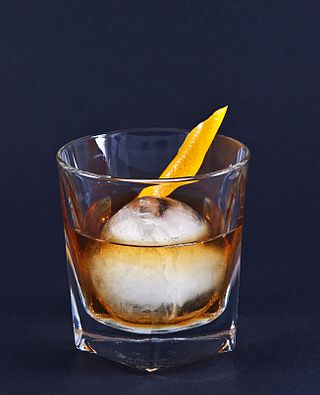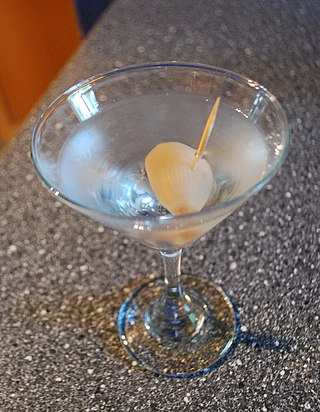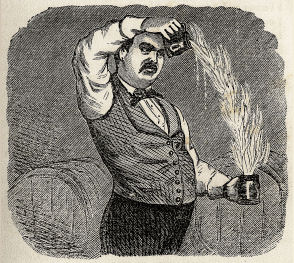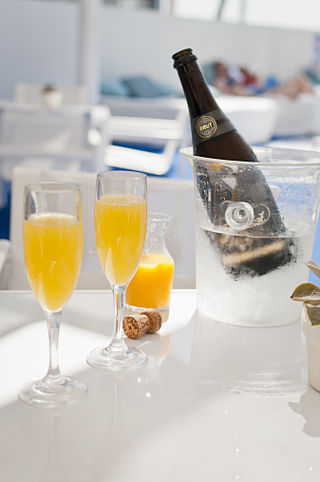
A cocktail is an alcoholic mixed drink. Most commonly, cocktails are either a single spirit or a combination of spirits, mixed with other ingredients such as juices, flavored syrups, tonic water, shrubs, and bitters. Cocktails vary widely across regions of the world, and many websites publish both original recipes and their own interpretations of older and more famous cocktails.

A Manhattan is a cocktail made with whiskey, sweet vermouth, and bitters. While rye is the traditional whiskey of choice, other commonly used whiskies include Canadian whisky, bourbon, blended whiskey, and Tennessee whiskey. The cocktail is usually stirred then strained into a cocktail glass and garnished traditionally with a maraschino cherry. A Manhattan may also be served on the rocks in a lowball glass.

The old fashioned is a cocktail made by muddling sugar with bitters and water, adding whiskey, and garnishing with an orange slice or zest and a cocktail cherry. It is traditionally served with ice in an old fashioned glass.

The Sazerac is a local variation of a cognac or whiskey cocktail originally from New Orleans, named for the Sazerac de Forge et Fils brand of cognac brandy that served as its original main ingredient. The drink is most traditionally a combination of cognac or rye whiskey, absinthe, Peychaud's Bitters, and sugar, although bourbon whiskey is sometimes substituted for the rye and Herbsaint is sometimes substituted for the absinthe. Some claim it is the oldest known American cocktail, with origins in antebellum New Orleans, although drink historian David Wondrich is among those who dispute this, and American instances of published usage of the word cocktail to describe a mixture of spirits, bitters, and sugar can be traced to the dawn of the 19th century.

The martini is a cocktail made with gin and vermouth, and garnished with an olive or a lemon twist. Over the years, the martini has become one of the best-known mixed alcoholic beverages. A popular variation, the vodka martini, uses vodka instead of gin for the cocktail's base spirit.

The Singapore sling is a gin-based sling cocktail from Singapore. This long drink was developed sometime before 1915 by Ngiam Tong Boon, a bartender at the Long Bar in Raffles Hotel, Singapore. It was initially called the gin sling.

A sour is a traditional family of mixed drinks. Sours belong to one of the old families of original cocktails and are described by Jerry Thomas in his 1862 book How to Mix Drinks.

The Prince of Wales is a cocktail created by Albert Edward, Prince of Wales, who later became King Edward VII. There are several variations of the cocktail, but what they usually have in common is champagne, angostura bitters, sugar, either rye whiskey or cognac, and a liqueur.

The Fine Art of Mixing Drinks is a book about cocktails by David A. Embury, first published in 1948. The book is noteworthy for its witty, highly opinionated and conversational tone, as well as its categorization of cocktails into two main types: aromatic and sour; its categorization of ingredients into three categories: the base, modifying agents, and special flavorings and coloring agents; and its 1:2:8 ratio for sour type cocktails.

The Gibson is a mixed drink made with gin and dry vermouth, and often garnished with a pickled onion. In its modern incarnation, it is considered a cousin of the ubiquitous martini, distinguished mostly by garnishing with an onion instead of an olive. But the earliest recipes for a Gibson – including the first known recipe published in 1908 – are differentiated more by how they treat the addition of bitters.

Jeremiah "Jerry" P. Thomas was an American bartender who owned and operated saloons in New York City. Because of his pioneering work in popularizing cocktails across the United States as well, he is considered "the father of American mixology". In addition to writing the seminal work on cocktails, Bar-Tender's Guide, Thomas displayed creativity and showmanship while preparing drinks and established the image of the bartender as a creative professional. As such, he was often nicknamed "Professor" Jerry Thomas.

A mimosa cocktail consists of champagne and chilled citrus juice, usually orange juice. It is often served in a tall champagne flute at brunch, at weddings, or as part of business or first class service on some passenger railways and airlines. The mixing ratio varies.
The corpse reviver family of named cocktails are sometimes drunk as alcoholic hangover tongue-in-cheek "cures", of potency or characteristics to be able to revive even a dead person. Some corpse reviver cocktail recipes have been lost to time, but several variations commonly thought to be tied to the American Bar at the Savoy Hotel remain, especially those espoused by Harry Craddock that originally date back to at least 1930 and are still being made. Many "reviver" variations exist and the word is sometimes used as a generic moniker for any morning-after cocktail, also known as a "hair of the dog".
Boker's Bitters was a brand of bitters manufactured by the L. J. Funke Company of New York City. The ingredient is specified in nearly every cocktail that called for bitters in Jerry Thomas' 1862 book, How to Mix Drinks or The Bon Vivant's Companion. Among the ingredients were cassia, cardamom, and bitter orange peel.

The suffering bastard is the name for two different mixed drinks, one being more of a standard cocktail associated with World War II and the other being more of an exotic drink associated with Tiki bars. As is the case with many cocktails, there are multiple recipe variations and historical origins have been argued and changed over time. Two of the earliest recipe versions have very different ingredients. One from bartender Joe Scialom (1942) calls for brandy and gin, while another from Tiki pioneer Victor J. Bergeron primarily uses rum along with "secret ingredients" and is known for being garnished with a cucumber.

The Martinez is a classic cocktail that is widely regarded as the direct precursor to the Martini. It serves as the basis for many modern cocktails, and several different versions of the original exist. These are generally distinguished by the accompaniment of either Maraschino or Curacao, as well as differences in gin or bitters.

A brandy crusta is an IBA Official Cocktail made of brandy, Maraschino Luxardo, curaçao, fresh lemon juice, sugar syrup, and Angostura bitters.
A sherry cobbler is a classic American cocktail made with sherry, sugar and citrus. Its origins are not known in detail, but is believed to have originated sometime in the early 19th century. The earliest known mention is from an 1838 diary of a Canadian traveler to the United States, Katherine Jane Ellice, but it did not gain international name recognition until Charles Dickens included the drink in The Life and Adventures of Martin Chuzzlewit. To make the drink, orange and lemon are muddled with simple syrup, shaken with ice in a cocktail shaker, and strained into a highball glass filled with crushed ice. Garnishes include mint leaves, raspberry, and orange and lemon slices. It can also be garnished with pineapple wedges or any seasonal berries. Some recipes add pineapple juice.















